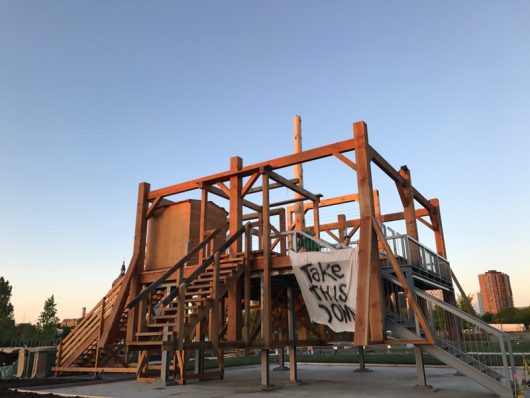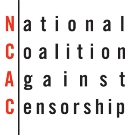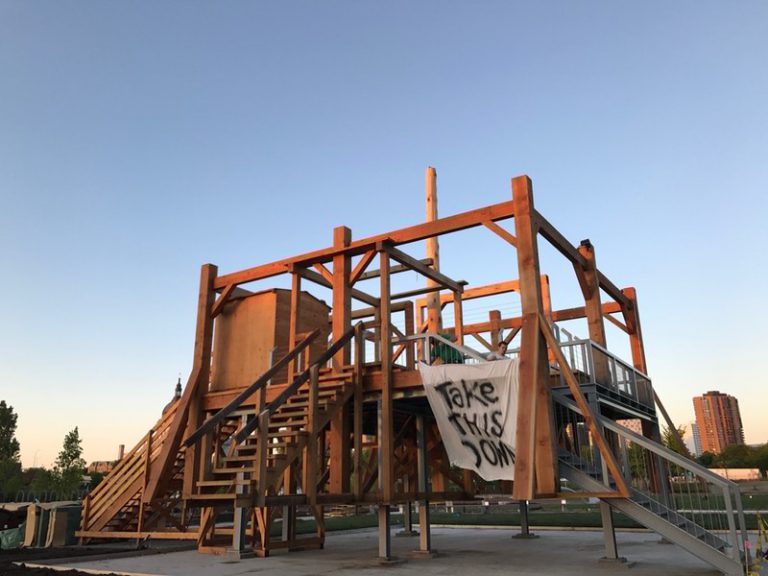
Sam Durant’s Scaffold (2012), Minneapolis Sculpture Garden, before it was dismantled.
UPDATE 9/7/2017: The wood used in Sam Durant’s controversial ‘Scaffold’ sculpture will be ceremonially buried and not burned, the New York Times reports.
The council that was established to deal with the sculpture’s remains and to work with the Walker on improving relationships with the local Native American community decided that burying the wood is a step toward healing. No date has been set yet for the burial.
Original post:
In late May, Minneapolis’ Walker Art Center became the center of a heated controversy over Scaffold, a massive 2012 work by Los Angeles artist Sam Durant intended to create awareness about capital punishment and its historically disproportionate effect on people of color. Scaffold is based on designs for gallows used in seven U.S. state-sanctioned executions, including 38 Dakota men hung in Mankato, Minnesota in 1862. The installation was not discussed in advance with the local Dakota community, and it sparked a protest and demands for it to be destroyed. After a meeting with Dakota tribal elders, a determination was made to dismantle the sculpture and burn the wood in a ceremony; Durant pledged to transfer his intellectual property rights to the work to the Dakota tribe. (The Dakota Nation has since suspended the ceremonial burning until further notice.)
NCAC has issued a statement signed by several national and international organizations, opposing the Walker’s decision to dismantle and destroy the controversial sculpture:

CONTACT: Jas Chana, NCAC Communications Director [email protected], 212-807-6222 ext.107
The Walker Art Center’s Decision to Destroy Sam Durant’s Installation Raises Concerns about Responses to Critique And Controversy
As a coalition of national and international organizations devoted to promoting creative freedom, we strongly oppose the Walker Art Center’s decision to dismantle and destroy a controversial public sculpture. Scaffold, a 2012 work by Sam Durant, was intended to comment on capital punishment and its disproportionate effect on people of color.
Scaffold is based on designs for gallows used for seven historical U.S. state-sanctioned executions, including that of 38 Dakota men hung in Mankato, Minnesota in 1862. Over a month after its installation in the Minneapolis Sculpture Garden the sculpture was met with a protest, threats of violence, verbal attacks on the artist and the Center’s administration, and demands that the work be dismantled and removed.
Days after the protest erupted, in a May 31st meeting, Dakota tribal elders, the artist, the Walker Art Center administration, the Minneapolis Park and Recreation Board, and city government officials, reached a decision to dismantle the work and burn it in a ceremony overseen by Dakota elders. As part of the agreement, Durant has pledged to never recreate the piece, and to transfer to the Dakota tribe his intellectual property rights to the work.
The hasty decision did not allow for time to obtain meaningful feedback from the broader community or consider various options to respond to the concerns raised by Dakota leaders.
Artists and art institutions have always played a role in socio-political discourse, including raising awareness about historical and present-day violence, injustice and oppression. There have been vigorous debates in recent years over who can appropriately represent historical trauma, the meaning of cultural appropriation and white privilege.
Cultural institutions and artists urgently need to develop creative ways to respond to such critique and controversy and productively engage diverse communities while taking seriously their responsibility for the artworks that are in their care. Without active institutional support for their work, artists—who can face extreme pressure on social media, ad hominem attacks and even physical threats—may feel they have little choice but to consent to their work’s destruction, to commit to avoiding certain subjects in their art (self-censorship), and or even to sign away their intellectual property rights.
The Walker’s decision to destroy Scaffold as a way to respond to protests sets an ominous precedent: not only does it weaken the institution’s position in future programming but sends a chill over artists’—and other cultural institutions’—commitment to creating and exhibiting political, socially relevant work. Even ostensibly voluntary decisions to destroy artwork have ominous implications for creative expression and the need for public debate over contentious social issues.
Read the statement below; click here for full screen view.


